Xylocopa
Ah, springtime!
Don’t you just love the glorious profusion of new life as gardens and landscapes wake up from their long sleep? The days get longer, flowers and trees blossom, and birds, butterflies, and cute critters return from their winter respite.
And, oh yes… so do the pests.
Pests like carpenter bees. With their giveaway, dime-sized holes that they chew in your wooden structures to build nests.

We link to vendors to help you find relevant products. If you buy from one of our links, we may earn a commission.
Now, it’s hard to get mad at these little insects, because they’re important pollinators. They’re docile as can be, and rarely sting, doing so only when forced to. In fact, the males don’t even have stingers – although they put on a good show of buzzing intruders.
But they do like to nest in dead wood. And structural components like beams, eaves, posts, and siding are all fair game.
To be fair, they don’t actually eat the wood and won’t devour a building like carpenter ants or termites do. And damage is usually minor and cosmetic in nature. But if left unchecked, over time the damage can worsen and lead to more serious problems such as decay, moisture retention, and rot.
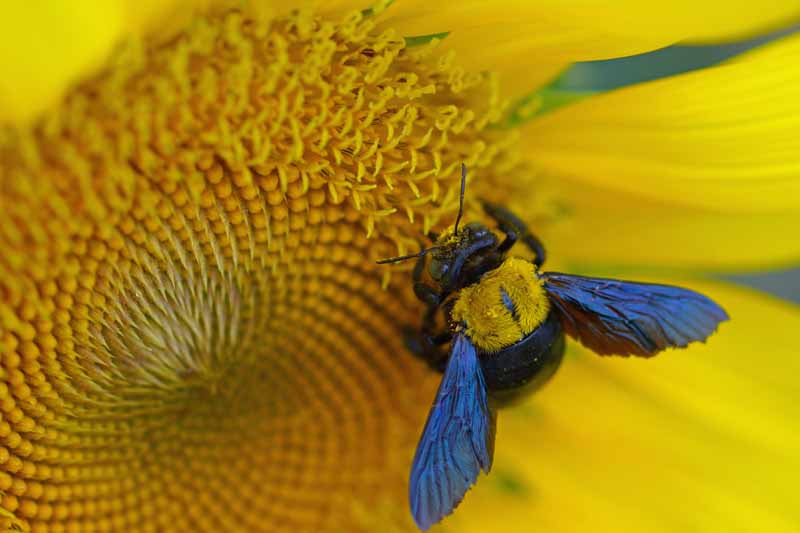
So, if you think carpenter bees have set up shop in your shop, please read on.
We have everything you need to identify a possible infestation and how to be rid of it – naturally if possible, but we dish on chemical warfare too!
What You’ll Learn
Identification and Biology
Carpenter, or borer bees, are in the genus Xylocopa of the Apidae family, with hundreds of species in several subgenera found around the world.
They’re aptly named for their nesting behavior of burrowing into dead wood to establish tunnels in order to lay eggs.
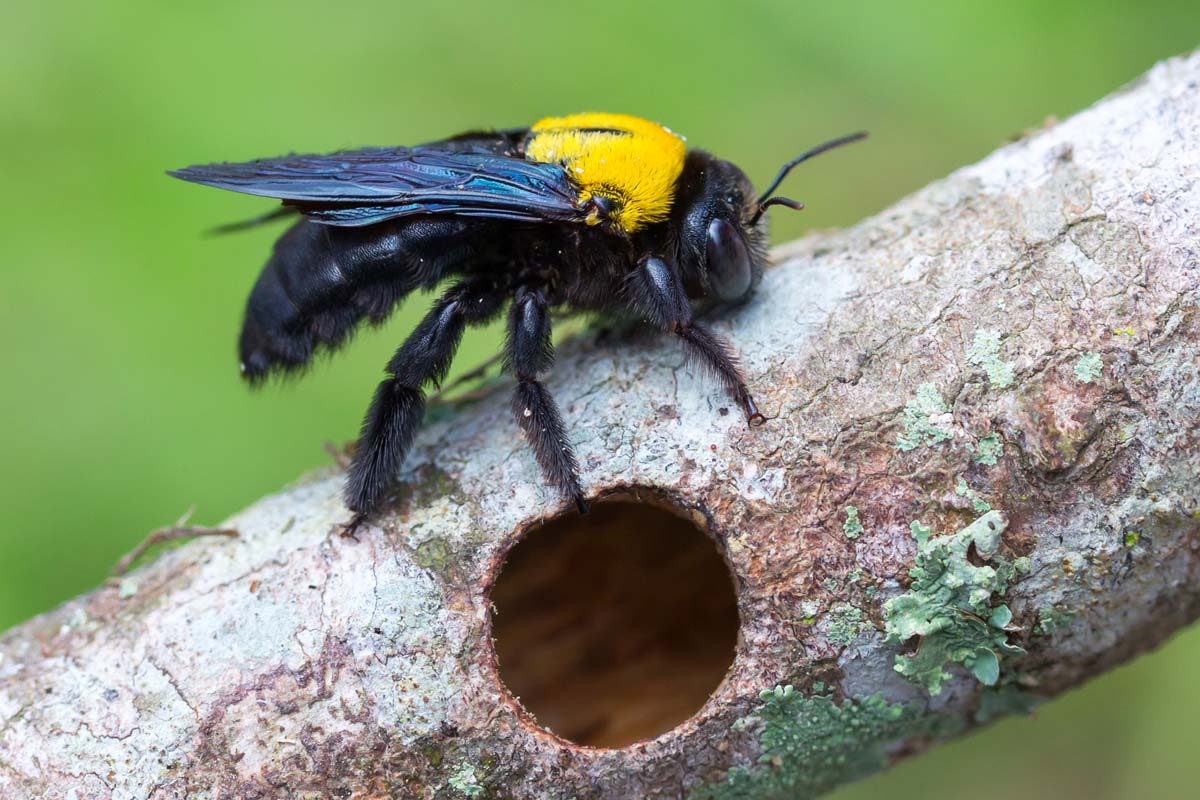
Featuring short mouthparts, carpenters are important pollinators on open-faced or shallow flowers and those that form lids. And for some species, like the maypop (Passiflora incarnata) and sea rose (Orphium frutescens), they’re the only pollinator.
Naturally docile, males don’t have stingers – although they will hover close to animals and people that approach nest sites. And the females only sting when aggressively provoked or handled.
Xylocopa are most active in the period of mid-late spring to early summer when they’re looking for suitable mates and nesting sites.
Measuring half to one inch in length, there are numerous variations to their colorings, many with black and yellow or black and orange markings. They have shiny, smooth abdomens, black in color with females often displaying metallic tones.
And there are some that have iridescent wings, as well as species with bright blue or chartreuse body hair.

Unlike many species that live in large colonies, carpenters are not social insects.
After mating, males will stick around to protect the nest. But it’s a solitary female that constructs the nest, forming long tunnels into which she lays the eggs.
Once laid, eggs go through another two stages of development, larva and pupa, before they emerge as adults approximately seven weeks later.
In several species, females may live near their own daughters or sisters, creating a small family social group.
Many species are similar in size and shape to bumblebees, and the two are often confused. And they’re often misidentified as ground-burrowing species as well.
Predators
Natural predators include badgers, mantises, predatory flies, and some birds such as bee-eaters, shrikes, and woodpeckers.
Unfortunately, woodpeckers will cause more damage by drilling into the wood beside nests to get at the grubs.
Nesting and Favored Habitats
Carpenter bees don’t actually eat wood. The females bore holes by using their mandibles as a rasp against the wood while vigorously vibrating their bodies.
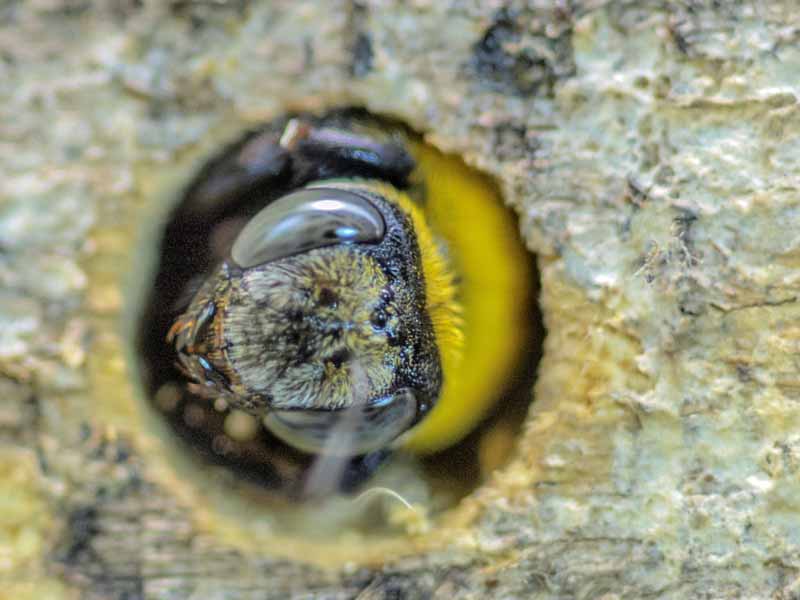
Each nest features a single entrance that usually spreads to connecting tunnels, called cells – these are the nurseries where eggs are deposited.
A new gallery measures around four to six inches in length, but those reused over several years can be 10 feet long!
Their favorite building material is soft, unpainted, and aged wood, although there are species that prefer hard woods.
And any wooden structure is suitable. Arbors, decks, eaves, fascia boards, gates, patio furniture, pergolas, porch ceilings, posts, siding, and window trim are all suitable sites.
Once the cell is ready, the mother provisions each one with a platform of pollen and nectar, called a pollen loaf, upon which a single egg is laid. She then partitions the cell with a wall of chewed wood pulp. Larvae will feed on the pollen loaf until they emerge from the nest.
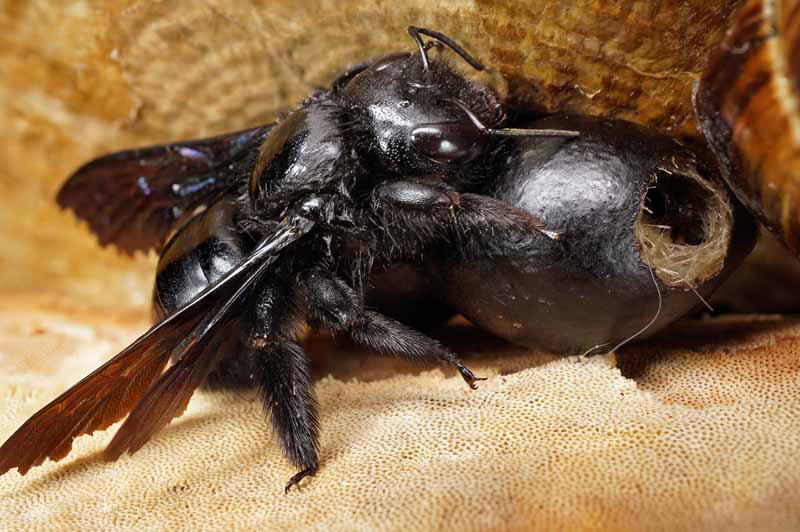
Adult carpenters will often overwinter in their original tunnels or find abandoned ones, which they stock with pollen to survive the cold.
The ones that survive the winter will emerge in spring to mate, with both the males and females dying after mating and laying eggs.
How to Identify Nesting Sites
The most obvious signs of an infestation are the round, half-inch holes that carpenters bore into wood as an entry point.
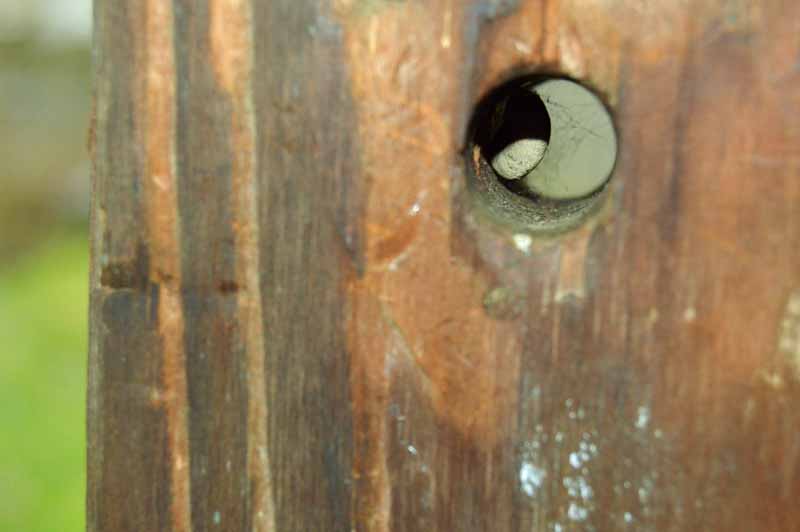
And if you spot several males hovering in one spot, it’s a good indication that a female, and her nest, are usually nearby.
In addition to the entry holes, there may also be a small pile of fresh sawdust outside the hole, scraping sounds from within the wood, or a fan-shaped stain below the opening.
Organic and Chemical Control Methods
Here are a few natural methods to make your home less attractive as a nesting site:
1. Bee Hotels
Hotels are constructed of removable bamboo, paper, or wood tubes housed in a small frame.
Typically used to provide nesting sites for garden-friendly pollinators like mason bees, hotels may provide an alternate site for females looking to nest.

JCs Wildlife Small Poly Lumber Bee House
This well-designed hotel that’s available on Amazon is a popular one, with a tough poly frame and charred pine burrows.
2. Citrus Oil
Citrus oil is a safe, natural repellent that carpenter bees dislike, and you can easily make your own at home.
Cut up a selection of peels from a variety of citrus fruits, place in a pan, and cover with water. Bring to a boil, then reduce heat and simmer for 10 minutes. Remove from heat, allow to cool, then strain and pour the water into a spray bottle.
Douse the nest with your spray and reapply until all the females have relocated, then repair and paint the wood as described in the next tip.
I haven’t tried citrus oil for insects, but it is my personal favorite to prevent deer from grazing in the garden. And it repels rodents as well.

Pure Cold Pressed Orange Oil Concentrate
If you’re not inclined to make your own spray, you can pick some up online. Like this one-quart bottle of orange oil available on Amazon – it has 80 to 95 percent D-limonene, the active ingredient in citrus oils.
3. Dress Exposed Wood
It’s easier to be proactive in discouraging carpenters than it is to react to their destructive burrowing.
To dissuade them from starting nests, paint all exposed surfaces with a primer and two coats of exterior paint. Stains and varnishes also offer some protection but are less effective than paint.
Before you paint, fill all cracks, nail holes, and splinters with caulk, putty, or wood filler as any existing damage provides an appealing point to start a nest.
4. Fill Abandoned Holes
As overwintering adults emerge in spring and new ones come out in late summer, stuff the entrances with caulk, a dowel, wadded aluminum foil, spray foam insulation, or steel wool.
Smooth the surface and paint as outlined above.
5. Hang a Decoy Wasp Nest
Carpenter bees will avoid nesting in the same area as wasps.
To mimic the shape and size of a wasp nest, stuff a brown paper bag with lightweight material such as moss, paper, or plastic bags. Tie off the open end with a length of string and hang it in the area you want to protect.
Keep in mind that this only works to deter them from building new nests – it won’t keep insects away from an existing nest in the area.

You can pick up a 3-pack of decoy wasp nests now on Amazon.
6. Lay a Trap
An easy method to get rid of your infestation is to place a trap near the nest.
A trap consists of a wooden top with angled holes drilled into it and a plastic container or jar attached to the bottom.
Because of the angle of the holes, the only light source comes from the bottom. The bees enter the hole, head for the light in the jar, then can’t get back out.
Traps should be located directly above an active nest. It may take a while for the trap to work, but once one or two have entered and released pheromones, others will be attracted to the site as well.

Original B Brothers-Carpenter Bee Trap, Set of 2
If you’re handy with woodworking, you can make your own. Or you can pick them up at pest control and garden shops or online – like these from Original B Brothers, available on Amazon.
7. Turn Up the Tunes
It turns out that bees communicate through vibroacoustics, and they can “hear” low frequency sounds of up to 500 Hz.
This makes them sensitive to vibrations, and they can be encouraged to vacate nests by playing loud music close by.
Choose music with a deep, reverberating bass line (a bass guitar has low frequencies) and place the speaker right against the wall beside their location – then crank up the volume!
Once the females have vacated, plug the hole and paint.
8. Use a Tennis Racket
In the spring when bees are most actively seeking nesting sites, you can dispatch flying critters with a good backhand.
Use an old badminton, tennis, or squash racket and patrol on a sunny day, giving a smack to those eyeing up your wood.
9. Insecticide Spray
Deterring carpenters with natural solutions is the preferred method, but if you must pull out the big guns, here’s our first suggestion:
Products like flying insect sprays will kill the queen and her eggs.
Spectracide Carpenter Bee Foaming Aerosol via Amazon
Use a liquid or aerosol product with an extension tube and apply directly into the hole. Application should be done at night while they’re resting, or in early spring before they emerge from hibernation.
If you choose this method, always read and follow label instructions and wear protective gear as needed.
10. Carburetor Cleaner and WD40
An old farmers’ alternative to insecticides is to use an aerosol such as carburetor cleaner or WD40.
These petroleum-based products will effectively kill any insects. Use a spray with an extension tube to get into the tunnels.
11. Petroleum
A little gasoline in a spray bottle can be an effective homemade insecticide as well.
Spray the entrance regularly until there’s no more activity.
This is a technique likely used by your grandparents in the past. We don’t recommend it and would choose another method. It may not even be (bee?) legal with the stricter environmental laws that are in place today in many areas.
Of course, petroleum and petroleum-based products are highly flammable and should never be used near an open flame or an ignition source. When finished, be sure to label your spray bottle to avoid accidental misuse, and don’t store in the house or in high temperature environments such as outbuildings without air conditions.
We are not responsible for accidents or Darwin Award winners. Use at your own risk!
With all chemical applications, avoid getting the products on your skin or inhaling the fumes. Wear eye protection, a respirator, and gloves when applying chemical products.
Buzz Off!
With a little seasonal maintenance of your wooden structures, you can do a lot to prevent carpenter bee infestations.
Keep up a regime of repairing any damaged wooden surfaces, repair holes on a regular basis, and paint surfaces.
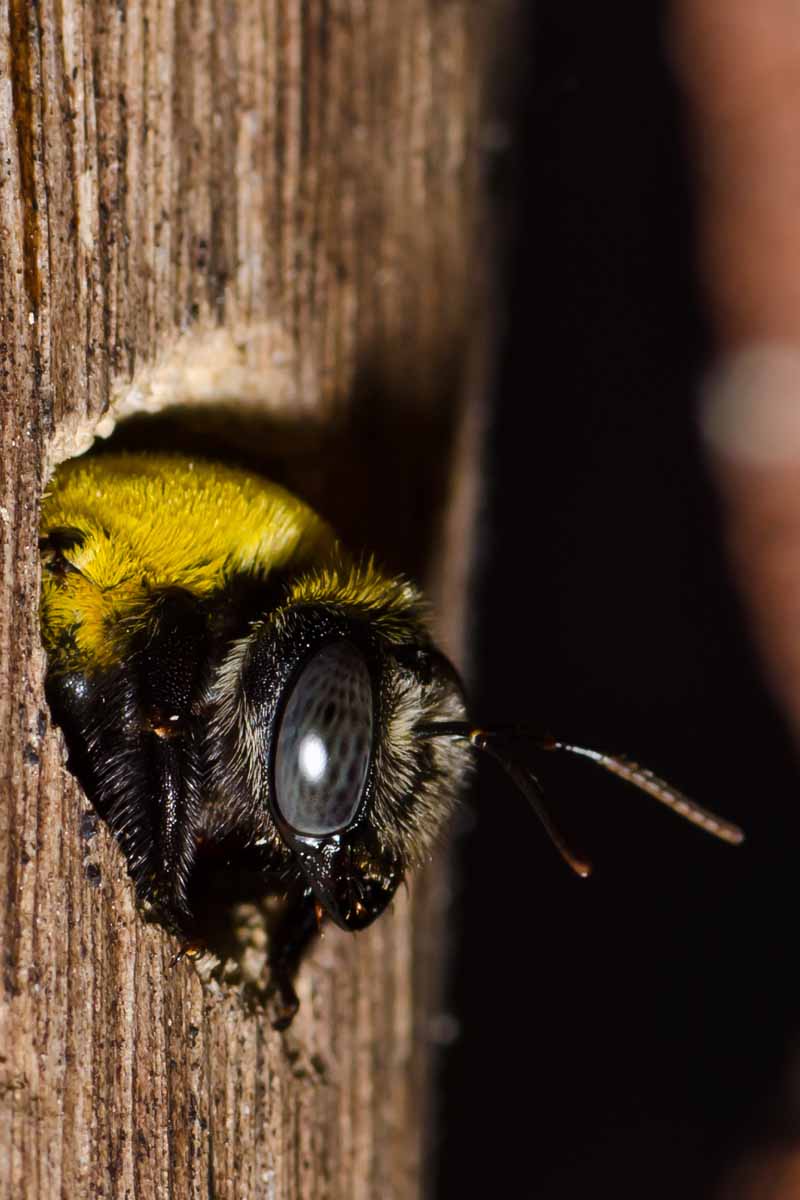
If you do have an existing infestation, try one of the solutions above or hire a pest control expert to do it for you.
But please remember that these are gentle little creatures performing a vital service for our well-being! If possible, lure them out and tell them to buzz off before resorting to killing them.
Do you folks have any favorite solutions for getting rid of these flying insects? Shoot us a line in the comments below. And be sure to check our guides on garden diseases and insects for other pest solutions, or buzz on over to these articles to increase your knowledge:

When I finished reading this article my first thought was “ok it must be really old because a lot of these suggestions just advocate for products that hurt the environment” Its a 2019 article. Carpenters are important native bees and pollinators, I agree with people wanting to protect their wood and some of the solutions here are understandable. However, as far as using sprays, petroleum, insecticides, it is contradictory that the author talks about being hooked on organic and natural methods in her bio but has suggested these in the first place.
Many of our writers are committed to organic practices. Sitewide, we often offer both conventional and organic solutions for common gardening problems including pest eradication, and recommend chemical controls as a method of last resort.
Gasoline, WD40, and carb Cleaner are not approved pesticides. So this advice definitely not Organic. Definitely not even Conventional. It is illegal.
Thanks for your note, Shawn. We do provide many conventional as well as organic treatments for pests in our articles. As stated above, this is an old-fashioned method that was once common among some gardeners. But as the author of this piece stated, “We don’t recommend it and would choose another method”!
Technically, those methods are organic. Organic chemistry is carbon based chemistry. Petroleum products are all long chain carbon molecules and are know as hydrocarbons.
Your crystals and gemstones, glass beads and water (alkali and all others) are inorganic; contain no carbon. Hydrocarbons are the most organic.
This is abundantly true, in a technical sense. Thank you for sharing your input! We’re referring more to organic cultural, mechanical, and biological practices and regulations in agriculture and gardening that support biodiversity and the environment, rather than pure chemistry. Synthetic fertilizers and conventional pesticides and herbicides, for example, as well as gasoline or something like WD-40, would not be deemed “organic” in this context. Hope that makes sense! I apologize if you found the use of this term misleading – you seem to have missed the point.
Eugenia/KAREN
Get a life…. if I could only capture my destructive bee army, I’d gladly deliver them to take down your house. We had 32 deep holes in our cedar porch frame and post before I noticed them. Fought them awhile on my own before we sold our house. The buyer’s inspector said we either get a professional exterminator or the sale was off. The exterminator used his application and put up a warning barrier telling humanoids to avoid the area for 3 days. Bees gone. House sale closed.
Amen……
How far do I need to travel to release the bees so they do not return to my house?
Hi Maggie, to ensure they don’t return they should be moved a minimum of two miles away.
The best time to move them is before sunrise or after sunset when they’re all at home, or on a cool, wet day when they’re not out foraging.
Avoid moving them on hot days as they need to find water in their new location – and they’ll appreciate a mist of water around the hive in their new home so they can find a few drops of moisture quickly.
Hope that helps, and thanks for asking!
Hello, How safe is boracare? We had planned on installing aluminum railing but the cost of that compared to wood is quite a bit more expensive and i’ve looked at different websites and came across boracare. Thank you
Hi Pira – Bora-Care is a wood treatment for new lumber that contains borate compounds obtained from alkaline salts – the active ingredient is disodium octaborate tetrahydrate.
These compounds are are toxic to insects, fungus, and algae but have a low toxicity for humans and pets.
However, it is listed as hazardous by OSHA in the USA and WHMLS in Canada because of reproductive and developmental effects found in animal studies.
Hope that helps, thanks for asking!
I have a carpenter bee who is insistent on creating a nest in my wood frame of my French door. For two days, she has tried, and I swat her away with a broom ( no harm to her). This IS a painted surface! What can I place up there to distract her from boring?? WD40? Don’t want to kill her…
Hey Karin, you can try a natural, and gentler, bee repellent that you can make at home. Fill a spray bottle with water and add a two teaspoons of liquid dish soap, a few drops of peppermint oil, plus 1/8 teaspoon each of ground cinnamon and cayenne pepper. Shake well. Spray your French door and surrounding frames with the mixture and allow to dry in the sun. (Test a small area first to ensure your paint is colorfast.) As the water evaporates, it leaves behind the strong scents of peppermint, cinnamon, and cayenne – which, hopefully, is enough to send… Read more »
She will lay thousands of eggs in your door and ruin it if you don’t kill her. There’s plenty more where she came from, but they don’t want your door. I’m here because I let one live and the eggs hatched. It ain’t pretty.
I have had an infestation of carpenter bees & they have attacked wooden gazebo, fence, gate, painted cedar shutters & house trim. Certain they will be back again. Just want them GONE! Leaf cutter bees are one thing – carpenter bees are very destructive & cause great expense. We’ve tried almost
everything – with the exception of what actually works.
I like em
I use a tennis racquet. Live in a log cabin. House gets riddled with holes from these bees. I’ve swatted approx 50 of them each spring. I hate to do it but have to protect the logs from moisture. I am going to try fake hornet nests. Hope it deters them. I know they are good pollinators and with bee populations declining, it bothers me but it’s either them or thousands in repairs annually.
what if that fake hornet nest magnets and eventually hosts real hornets eh? no fun 😉
Are carpenter bees destroying your home or surrounding buildings? They are at my house and we’ve spent thousands of dollars trying to prevent and deter them. I will try anything at this point, they are destroying our home, cabana, fences, etc, etc?….I’ve been patient but now I’m am DONE!
I don’t care about carpenter bees, we need to save YELLOW BEES NOT THESE MONSTERS! I moved from wa to SC and wa is perfectly fine without these type of bees plus many other countries don’t even have them. These monsters wake me up in a house I just bought and I AM NOT RICH! Stop “advocating” for “not harmful environment” stop being naive about these weirdos and DO NOT CONFUSE WITH OTHER INSECTS THAT ACTUALLY POLLUTE N HELP! Gush ppl are EXTREMELY NAIVE! Maybe you also want to save and red ants?! Ha? You wanna save them in humane… Read more »
When you have an infestation of carpenter bees on your home, then talk to me. I can tell you NONE of the home remedies work. I tried every new one I ran across for 10 years. I finally stated using a boric acid solution and that killed them. Just out of curiosity i counted how many bees fell out of one wall of my our house after spraying and it was over 1,000, just one wall. They are so destructive and costly. I am all about saving the environment but if you see them it is best to kill them… Read more »
I have an infestation everywhere, all along the house AND in my sheds, just moved here, not familiar with these bees but they need to go! Wasps too! Suggestions? I don’t have alot of money..
Hey Candace, I suggest you try some of the solutions outlined in the article or some of the remedies mentioned by other readers.
Sheila, did you simply spray on the exterior wood surface and this was effective or did you somehow spay into the holes?